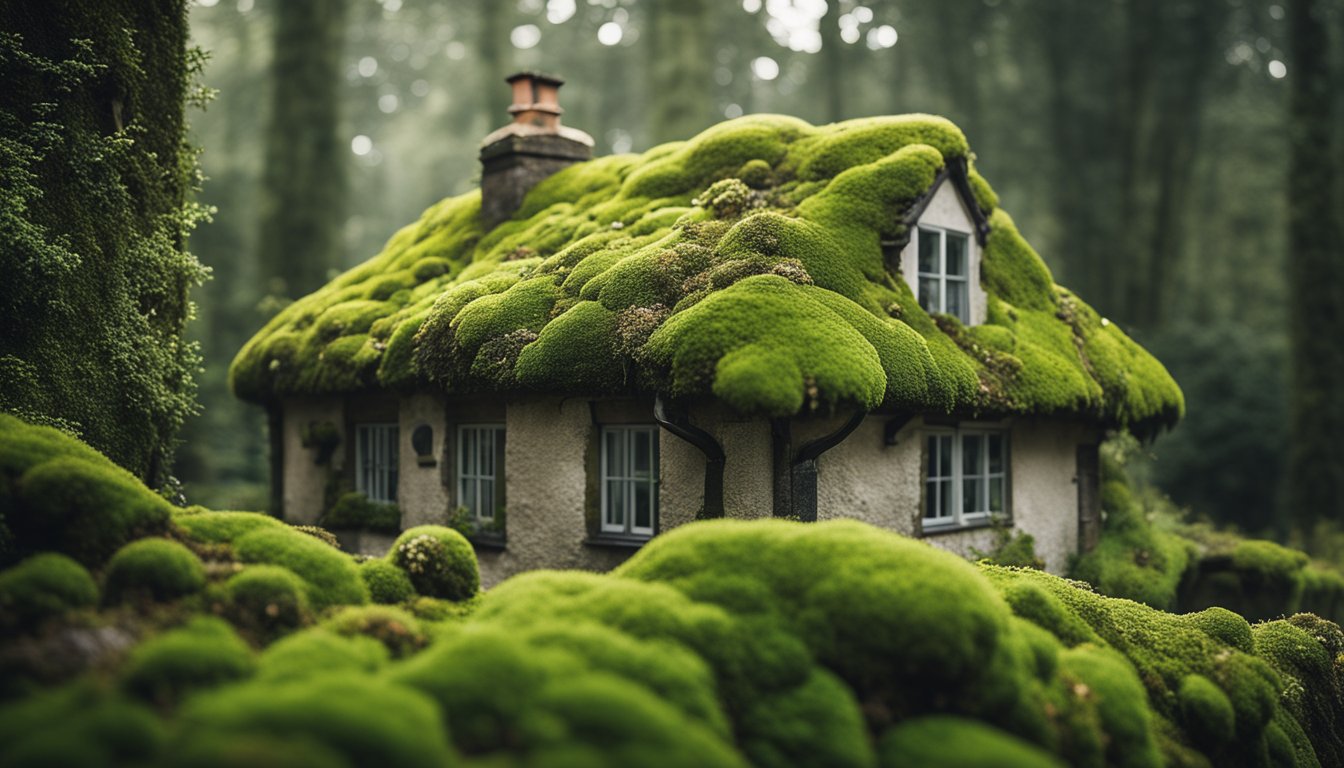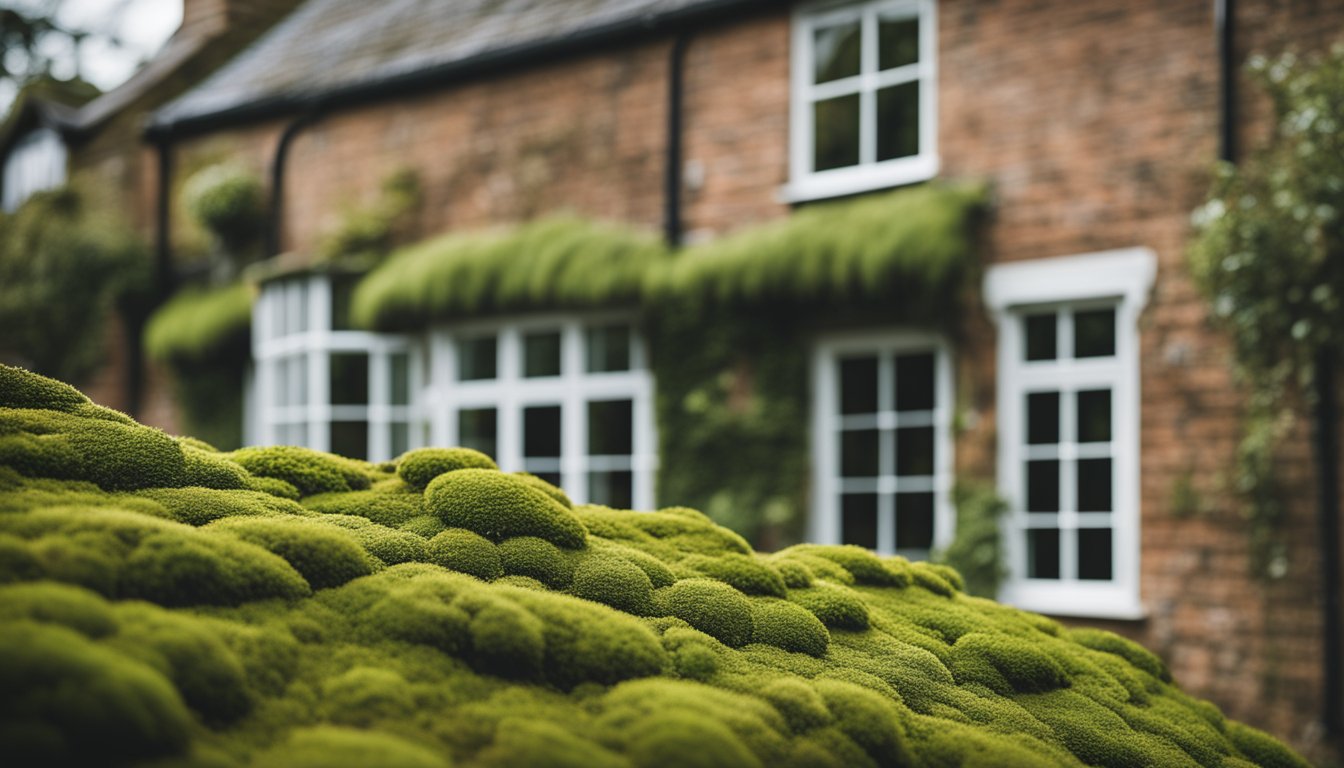Late updated: 22 Sep 2024 13:09
Written by: Oliver Bennett
How To Identify Roof Moss And Lichen On UK Homes: A Homeowner's Guide
For homeowners in the UK, the growth of moss and lichen on rooftops is a common occurrence, especially in areas with significant rainfall and overcast skies. These green or grey patches not only affect the appearance of roofs but can also impact their longevity if not addressed promptly. The key to maintaining a healthy roof is the effective identification and management of moss and lichen growth. Once identified, appropriate care and cleaning methods can be employed to mitigate potential damage and preserve the integrity of roofing materials.

Moss, with its dense mat-like structure, can trap moisture against the roof, leading to potential rot and decay, while lichen is often seen as a symbiotic blend of algae and fungus forming crusty or leafy growths. Each has distinct characteristics and requires different approaches for removal and prevention. Understanding these differences is crucial for choosing the right maintenance strategy for your home.
As we explore this topic further, we'll provide you with practical tips and invaluable insights into keeping your roof in top condition. By the end, you'll know exactly how to spot these growths and the best methods to tackle them.
Key Takeaways
- Learn to identify moss and lichen on your roof.
- Discover effective cleaning strategies for roof maintenance.
- Understand the causes and effects of moss and lichen growth.
Recognising Roof Moss and Lichen

Moss and lichen are common on UK roofs, often leading to potential damage if not identified and managed promptly. Recognising these growths involves understanding their unique characteristics, as well as knowing how they might harm roofing materials.
Identifying Moss on Roofs
Moss typically appears as dense, green clumps, thriving in damp, shaded areas on roofs. Its presence can often be observed beneath overhanging branches or near drainage systems where moisture accumulates. Moss growth tends to keep water against roof tiles, potentially leading to issues like rot and structural damage over time.
While visually inspecting for moss, it's crucial to pay attention to areas with poor sunlight exposure, as they are more prone to moss proliferation. Moss can affect a range of materials including asphalt shingles and wooden roofs.
Detecting Lichen and Its Varieties
Lichen is a composite organism arising from algae and fungi, identifiable by its crusty, flat patches. These can vary in colour from green to yellow, such as the species Xanthoria parietina. Unlike moss, lichen does not retain water, but its growth can still compromise roof integrity.
Lichen varieties include crustose, foliose, and fruticose forms, each exhibiting distinct appearance patterns. Crustose lichens form flat, hardy surfaces, whereas foliose and fruticose lichens are more leafy and bushy respectively. Regular checks can help detect these before they cause noticeable damage.
Assessment of Roof Damage and Preventative Measures
As moss and lichen grow, they can lead to deterioration of roofing materials. Over time, this might cause leaks or block gutters. A thorough visual assessment helps identify areas needing immediate attention. Observing changes, such as discoloration or unusual surface textures, is beneficial.
Preventative measures are essential. Regular maintenance includes cleaning gutters, trimming overhanging branches, and inspecting roofs following severe weather. Applying anti-fungal treatments or installing zinc strips can provide extra protection against these organisms. Keeping surfaces dry and debris-free reduces growth opportunities, extending roof lifespan.
Effective Cleaning and Maintenance Strategies
Proper maintenance of our roofs is essential for preserving their longevity and aesthetic appeal. By employing suitable cleaning methods and ensuring continued maintenance, we can mitigate the growth of moss and lichen and protect attached features such as solar panels and gutters.
Choosing Appropriate Cleaning Methods
Selecting the right cleaning approach is crucial in effectively removing moss and lichen without damaging the roof. Manual scraping using brushes and specialised tools can be effective, though time-consuming. It offers a non-invasive alternative to pressure washing, which can be too harsh on some surfaces, like concrete roof tiles or slates.
For a gentler solution, we might consider a toxic wash solution. Mixing bleach and water in a conservative ratio, and applying it with a pump sprayer, can help to eliminate moss and lichen while safeguarding nearby plant life. It's important to rinse the roof adequately after the solution has been given time to work, preventing any lingering effects on roof features or the surrounding environment.
Long-Term Maintenance and Professional Care
Regular upkeep is key to preventing the return of unwanted organic material. Clearing gutters and trimming overhanging branches will reduce the shade and moisture that facilitate moss and lichen growth. Additionally, installing copper strips along the roof ridge can provide a natural defence by releasing copper ions during rainfall, which are unfavourable to these organisms.
In some cases, engaging with a roofing professional might be wise. Their expertise can ensure thorough maintenance and cleaning, particularly for complex setups involving roof-integrated solar panels or specific tile types like Marley solar tiles. A professional's insight is invaluable, particularly for those of us with pitched roofs complex surfaces that might harbour more robust growths.
Safeguarding Roof Features and Attachments
When addressing moss and lichen, we must also consider the safety of roof attachments like slates and solar panels. Cleaning solutions can cause damage if not properly managed. Hence, we should always shield these features or use targeted cleaning methodologies for them.
Points of attachment such as solar panels and roofing tiles should remain secure during cleaning. Tools like soft brushes and low-pressure spraying equipment minimize the risk of dislodgement or surface damage. Maintenance must also encompass checking and reinforcing these attachments periodically to ensure that our roofing system remains both functional and sustainable.
Frequently Asked Questions

In this section, we explore various aspects of roof moss and lichen on UK homes, including identifying their causes, removal methods, and potential risks. This information is essential for maintaining the health and longevity of roofs, ensuring they remain both functional and aesthetically pleasing.
What are the main causes of lichen growth on roof tiles?
Lichen growth on roof tiles is primarily influenced by environmental factors. Moisture, shade, and the presence of organic material on roofs contribute to lichen development. Lichens are more prevalent on surfaces that receive less sunlight, providing the damp conditions conducive to their growth.
How can one effectively eliminate moss from roof tiles without causing damage?
To eliminate moss effectively and prevent damage, it's crucial to use gentle cleaning methods. Low-pressure washing can safely dislodge and rinse away moss. For a more thorough clean, consider applying a moss-specific cleaning solution, ensuring it is safe for roofing materials and applied as per the manufacturer's guidelines.
What natural methods can be utilised to kill roof lichen effectively?
Natural methods for removing roof lichen include using eco-friendly solutions like vinegar. Apply the vinegar directly to the affected areas, allowing it to sit before gently scrubbing with a brush. Alternatively, manual removal techniques, like hand-scraping or brushing, can effectively tackle lichen without harming the environment.
What are the distinguishing characteristics between moss and lichen found on roofs?
Moss and lichen on roofs differ in appearance and texture. Mosses are green, soft, and spongy, often forming thick mats. Lichens, however, have a more crusty or scaly texture and vary in colour from grey to green. Understanding these differences aids in proper identification and treatment.
Are there any implications for ignoring moss growth on rooftops in the UK?
Neglecting moss growth on rooftops can lead to several issues. Moss retains moisture, which can cause roofing materials to deteriorate, potentially leading to leaks or structural damage. Additionally, moss can negatively affect energy efficiency by reducing the roof's capability to reflect sunlight, increasing heating and cooling costs.
What precautions should be taken when removing moss from thatched roofs?
When dealing with moss on thatched roofs, it's vital to proceed with care to avoid damaging the delicate structure. We recommend using a soft brush or hand tools to carefully remove the moss. Avoid using chemical treatments or pressure washers, as they can harm the thatch material. Employing a specialist may also be necessary to preserve the roof's integrity.
